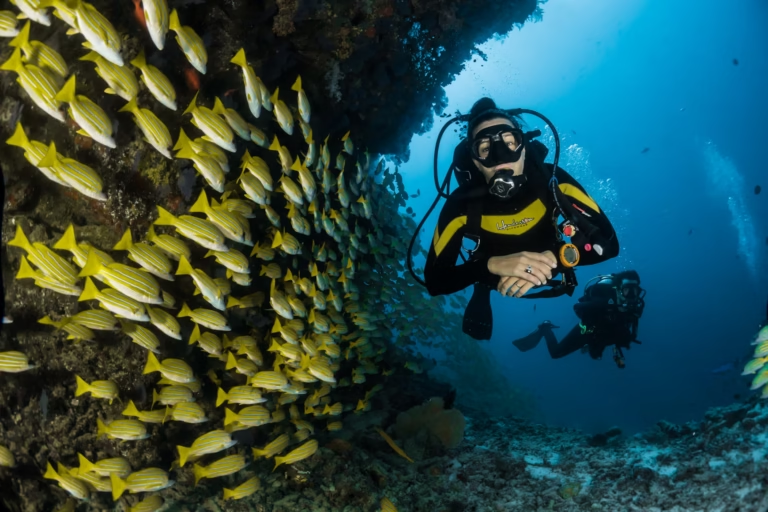The Ultimate Scuba Dive Checklist for Beginners

Excited to dive into the underwater world but not sure where to start? No problem. This simple scuba dive checklist will help you stay prepared and stress-free.
From essential gear to safety must-haves, everything you need is here to make your first dive smooth and memorable.
P.S – A printable Pre/Post Dive Checklist is available below.
Why a Scuba Dive Checklist is Important
Preparation is everything when it comes to scuba diving. It’s a technical activity, and forgetting even one small item can derail your day.
Ensuring Safety and Comfort
A scuba dive checklist ensures you don’t forget critical items. With the right gear and essentials, your dive will be safer and more comfortable. This means you can focus fully on the underwater world without worrying about what you might have missed.
Reducing Stress and Anxiety
Checklists do more than just keep you organized—they help reduce stress. Knowing everything is packed gives you peace of mind. For beginners, this is especially important, as diving can feel overwhelming at first. A checklist keeps the focus on the adventure, not the logistics.
Staying Organized for Future Dives
Using a checklist isn’t just for your first dive—it’s a habit that pays off long-term. It helps you track your gear, maintain it, and build a reliable pre-dive routine. Staying organized boosts your confidence, which leads to better, more enjoyable dives.
Essential Scuba Dive Gear Checklist

The right gear is the backbone of a good dive. Every item is crucial for your safety, comfort, and ability to enjoy the underwater world.
Here’s a clear checklist of essential scuba diving equipment:
Mask, Snorkel, and Fins
- Mask: A well-fitted mask is essential for clear vision. Make sure it seals tightly without being uncomfortable.
- Snorkel: Useful for conserving air while swimming at the surface.
- Fins: Pick fins that fit snugly and feel comfortable. They should provide strong propulsion without causing cramps.
Wetsuit or Drysuit
- Wetsuit: Great for warm to moderately cold water. Choose a thickness between 3mm and 7mm based on the water temperature.
- Drysuit: Better for cold water, keeping you warm and dry by insulating you from contact with water.
Buoyancy Control Device (BCD)
Your BCD manages buoyancy underwater. Choose one that fits well, adjusts easily, and has storage for accessories.
Regulator and Alternate Air Source
- Primary Regulator: Supplies air from the tank to your mouth.
- Alternate Air Source (Octopus): A backup air supply for emergencies or to assist your dive buddy.
Dive Computer or Depth Gauge
- Dive Computer: Tracks depth, dive time, and decompression limits to keep you safe.
- Depth Gauge and Dive Watch: Use these if a dive computer isn’t available.
Weights and Tank Setup
- Weights: Counteract the buoyancy of your body and wetsuit or drysuit.
- Tank: Ensure it’s filled and securely attached to your BCD.
Optional but Helpful Items
- Underwater Camera: Capture memories of your dive.
- Dive Torch: Improve visibility in low-light areas or when exploring caves and wrecks.
Make sure everything is checked, packed, and working properly before heading out. Double-checking your gear avoids last-minute problems and ensures you’re ready for any dive scenario.
Pre-Dive Preparation Tips

Getting ready for a dive isn’t just about the gear—it’s about preparing yourself physically and mentally. These tips will help you dive safely and enjoyably.
Health Check
Your health has a direct impact on dive safety.
- Skip the dive if you’re sick: Conditions like a cold, flu, or sinus congestion can make equalizing pressure difficult and painful.
- Medications: Be cautious with medication. Check with your doctor if you’re unsure.
- Get enough rest: A full night’s sleep keeps you sharp and ready.
Hydration and Nutrition
What you eat and drink matters before a dive.
- Drink water: Diving can dehydrate you, so stay hydrated before and after.
- Stick to light meals: Heavy meals can cause discomfort underwater.
- Avoid alcohol: Alcohol increases dehydration and affects judgment. Save it for after the dive.
Gear Check
Double-check your gear to avoid surprises.
- Mask and fins: Look for any cracks or damage.
- Regulator and BCD: Test for leaks or issues.
- Tank pressure: Make sure it’s filled to the proper levels.
- Dive computer: Ensure the battery is charged and the settings are correct.
Dive Plan
Never dive without a clear plan.
- Talk with your buddy: Go over dive goals, signals, and emergency procedures.
- Check conditions: Make sure water temperature, visibility, and currents are suitable for your skill level.
- Set limits: Agree on a maximum depth and dive time, and stick to them.
Mental Preparation
Your mindset matters just as much as your physical prep.
- Stay calm: Visualize a smooth, safe dive to ease any nerves.
- Ask questions: If you’re diving with an instructor, don’t hesitate to clarify anything you’re unsure about.
By following these steps, you’ll be physically and mentally ready for a successful dive. Preparation builds confidence, and confidence makes diving more enjoyable.
Safety Essentials to Include

Safety should always be your top priority when scuba diving, especially as a beginner. Diving is safe when done right, but having the right safety tools and mindset adds extra protection. Here’s a list of must-have safety items for every dive.
Dive Knife or Cutting Tool
This isn’t about self-defense; it’s a practical tool.
- Entanglement hazards: Use it to cut fishing lines, kelp, or debris that could trap you.
- Placement: Secure it to your leg or BCD for quick access.
Surface Signaling Devices
These tools help you get attention if needed.
- Whistle: A simple way to signal for help at the surface.
- Inflatable Marker Buoy (SMB): Makes you visible to boats and rescuers from a distance.
- Signal mirror: Reflects sunlight to signal over long distances.
First Aid Kit
A small kit is handy for minor issues before or after a dive.
- Bandages and antiseptic: For small cuts or scrapes.
- Burn cream or aloe vera: Helps with sunburns or stings.
- Pain relievers: Useful for minor aches or discomfort post-dive.
Dive Logbook
This isn’t just for keeping records; it’s a safety tool.
- Track experience: Document conditions, depth, and time of each dive.
- Learn and improve: Reviewing logs helps you identify what to work on.
- Future reference: Plan similar dives or share details with instructors and dive buddies.
Emergency Contact Information
Always have a waterproof card with key details.
- Emergency numbers: Include local services and your dive operator.
- Dive insurance info: Handy in case of a medical issue related to diving.
Backup Light
A backup dive torch is critical in low-light or night dives.
- Improves visibility: Reduces risks and helps with underwater communication.
Packing these safety essentials gives you peace of mind and ensures a safer, more enjoyable dive. A prepared diver is a confident diver.
Dive Charts
Dive charts are indispensable tools for planning safe dives and avoiding decompression sickness (the bends).
- Planning no-decompression limits (NDL): Dive charts help you calculate how long you can stay at a specific depth.
- Surface interval planning: If you’re doing multiple dives, the chart assists in calculating how much time you need to safely off-gas nitrogen.
- Digital alternatives: While many divers rely on dive computers, having a dive chart as a backup is crucial in case of device failure.
Post-Dive Checklist

The end of your dive is just as important as the start. Proper care after diving keeps your gear in great shape and helps you monitor your health. Follow this checklist after you surface:
Rinse and Dry Your Gear
Taking care of your equipment makes it last longer and ensures it’s ready for your next dive.
- Freshwater rinse: Wash all gear, especially saltwater-exposed items, to prevent corrosion.
- Dry thoroughly: Hang your wetsuit, BCD, and other items in a shaded, ventilated area to avoid mold and odors.
- Inspect for damage: Check for wear or issues that may need fixing before your next dive.
Monitor for Decompression Sickness (DCS)
DCS is rare but serious, so watch for any warning signs.
- Symptoms: Joint pain, fatigue, dizziness, or difficulty breathing.
- What to do: Seek medical help immediately if you notice any symptoms.
Record Your Dive in Your Logbook
Logging your dive helps track progress and reflect on the experience.
- Note details: Record depth, water temperature, duration, visibility, and any unique encounters.
- Identify improvements: Write down what went well and what could be better next time.
Reflect and Plan for Your Next Adventure
Take time to close out the dive properly.
- Celebrate: Diving is a big achievement—enjoy the moment!
- Review your checklist: Note anything you forgot or gear that needs replacing.
- Set new goals: Plan your next dive and build on what you’ve learned.
Following this post-dive checklist keeps you prepared and confident for your next underwater adventure.
Conclusion
A well-prepared diver is a confident and safe diver. By following this scuba dive checklist, you’ll have everything covered for your first dive. From gathering the right gear to sticking to pre- and post-dive routines, these steps ensure you can focus on the incredible experience of exploring the underwater world.
The ocean is full of amazing sights and unforgettable moments waiting for you. With your checklist ready and your sense of adventure in tow, you’re set for a journey beneath the waves.
Dive safe, enjoy every moment, and welcome to the world of scuba diving!






